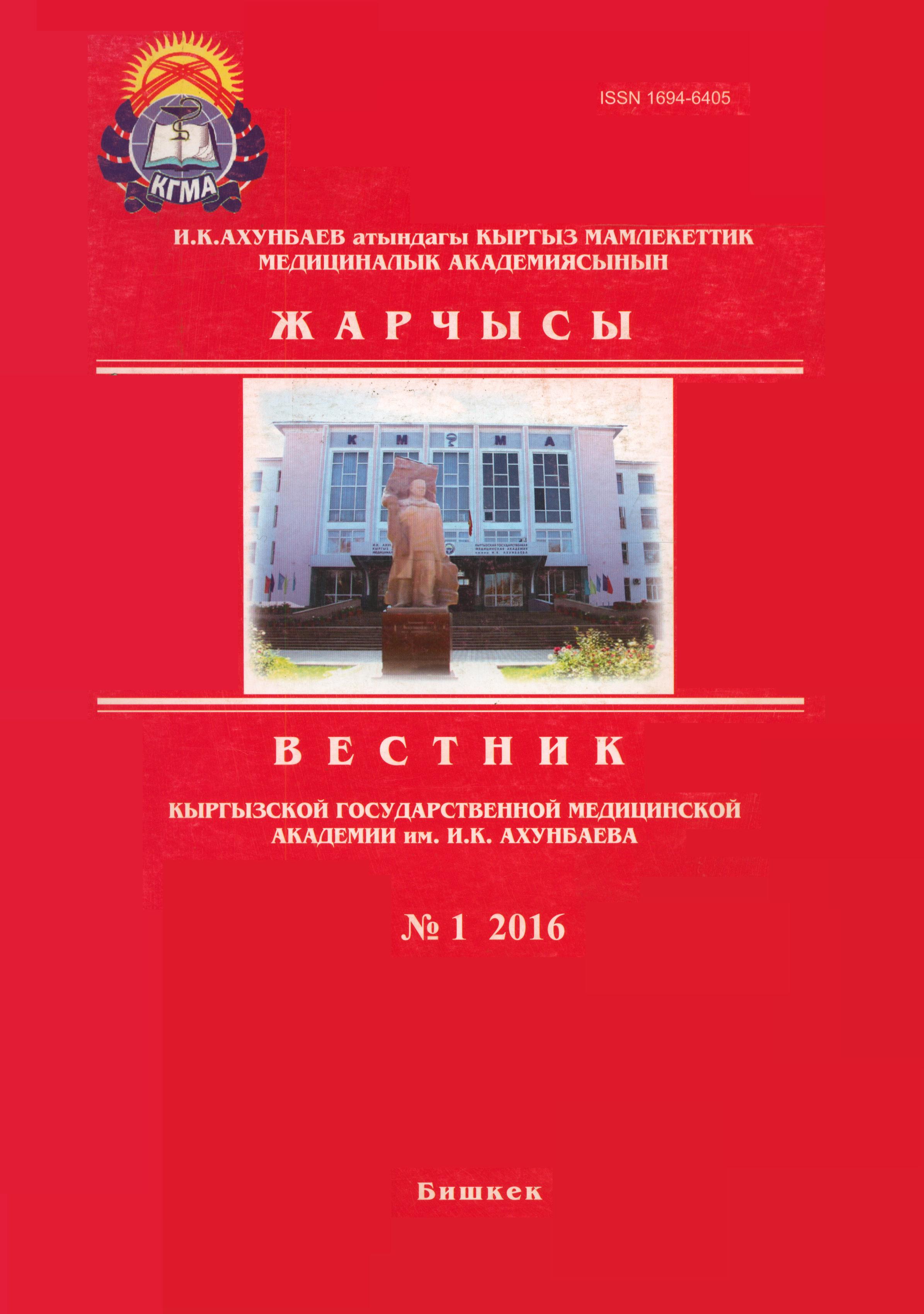УЙКУ АРТЕРИЯЛАРЫНЫН СУБКЛИНИКАЛЫК АТЕРОСКЛЕРОЗУ ИНСУЛИНТУРУКТУУЛУК МЕНЕН БАЙЛАНЫШЫ
Аннотация
Корутунду. Изилдөө максаты: кыргыз этникалык топтогу уйку артерияларынын экстракраниалдык бөлүмүнүн интима-медиа комплексинин калындыгынын инсулинтуруктуулук менен байланышын изилдөө.
Материалдар жана ыкмалар: изилдөөгө этникалык кыргыздар, Кыргыз Республикасынын туруктуу жашоочулары, киргизилген. Пациенттерге жалпы клиникалык текшерүү: даттануу жыйнамы, анамнез чогултуу жана объективдүү кароо өткөрүлгөн; антропометрикалык параметрлер (бою, салмагы, бел курчоосу (БК), сан курчоосу (СК)); кан басымы өлчөнгөн; дене салмагынын индекси эсептелген. Лаборатордук анализдерге липиддик спектр, кандагы кант (ачкарын), кандагы инсулин көрсөткүчтөрү аныкталган. Инсулинтуруктуулук абалына индекс НОМА≥2,77 көрсөткүчү алынган. Уйку артерияларынын интима-медиа комплексинин калындыгыны линейлүү кан тамыр датчиги 7,5 МГц (Phillips-SD 800) жардамы менен текшерилген.
Натыйжасы: изилдөөгө 144 этникалык кыргыздар алынган (69 эркек, 75 аял) 35-73 жашка чейин (орто курагы 51,03±8,2). Бардык пациенттер индекс НОМА квартилине жараша төрт топко бөлүнгөн: <1,26; 1,26-1,97; 1,98-3,26; ≥3,27. Индекс НОМА квартили көбөйүүсү менен интима-медиа комплексинин жоондугу да көбөйгөн (р<0,05). Интима-медиа комплексинин калындыгы гликемия, триглицерид, БК, СК, БК/СК, жана индекс НОМА көрсөткүчтөрү менен корреляциасы аныкталган (р<0,05).
Жыйынтыгы: изилденген этникалык кыргыздар тобунда уйку артерияларынын экстракраниал бөлүмүнүн интима-медиа комплексинин
калындыгы инсулинтуруктуулук менен байланышта.
Ключові слова:
субклиникалык атеросклероз, уйку артериялар, инсулинтуруктуулукПосилання
1. GBD 2013 Mortality and Causes of Death Collaborators. Global, regional, and national age-sex specific all-cause and causespecific mortality for 240 causes of death, 1990-2013: a systematic analysis for the Global Burden of Disease Study 2013. Lancet 2015; 385(9963):117-171.
2. Eckel R.H., Cornier M.A. Update on the NCEP ATP-III emerging cardiometabolic risk factors. BMC Med 2014; 26;12:115.
3. Fan J., Song Y., Chen Y., et al. Combined effect of obesity and cardio-metabolic abnormality on the risk of cardiovascular disease: a meta-analysis of prospective cohort studies. Int J Cardiol 2013;12;168(5):4761-8.
4. Santaniemi M., Ukkola O., Malo E., et al. Metabolic syndrome in the prediction of cardiovascular events: the potential additive role of hsCRP and adiponectin. Eur J Prev Cardiol 2014;21(10):1242-1248.
5. DeBoer M.D., Gurka M.J., Woo J.G., Morrison J.A. Severity of the metabolic syndrome as a predictor of type 2 diabetes between childhood and adulthood: the Princeton Lipid Research Cohort Study. Diabetologia 2015;58(12):2745-2752.
6. Lorenz M.W., Markus H.S., Bots M.L., et al. Prediction of clinical cardiovascular events with carotid intima-media thickness: a systematic review and metaanalysis. Circulation 2007;115:459e67.
7. Stein J.H., Korcarz C.E., Hurst R.T., et al. Use of carotid ultrasound to identify subclinical vascular disease and evaluate cardiovascular disease risk: a consensus statement from the American society of echocardiography carotid intima-media thickness task force. Endorsed by the society for vascular medicine. J Am Soc Echocardiogr 2008;21:93e111.
8. Eikendal A.L., Groenewegen K.A., Anderson T.J., et al. Common carotid intima-media thickness relates to cardiovascular events in adults aged <45 years. Hypertension 2015;65(4):707-713.
9. Kawamoto R., Tomita H., Oka Y., et al. Metabolic syndrome amplifies the LDL-cholesterol associated increases in carotid atherosclerosis. Intern Med 2005; 44: 1232-38.
10. Coutinho M., Gerstein H.C., Wang Y., Yusuf S. The relationship between glucose and incident cardiovascular events. A metaregression analysis of published data from 20 studies of 95,783 individuals followed for 12.4 years. Diabetes Care 1999;22:233e40.
11. Haffner S.J., Cassells H. Hyperglycemia as a cardiovascular risk factor. Am J Med 2003;8A(115 Suppl.):6Se11S.
12. Duckworth W., Abraira C., Moritz T., et al. Glucose control and vascular complications in veterans with type 2 diabetes. N Engl J Med 2009; 360:129e39.
13. Haffner S.M., Agostino Jr R.D., Saad M.F., et al. Carotid artery atherosclerosis in type-2 diabetic and nondiabetic subjects with and without symptomatic coronary artery disease (the insulin resistance atherosclerosis study). Am J Cardiol 2000;85:1395e400.
14. Bonora E., Kiechl S., Oberhollenzer F., et al. Impaired glucose tolerance, type II diabetes mellitus and carotid atherosclerosis: prospective results from the Bruneck study. Diabetologia 2000;43:156e64.
15. Friedewald W.T., Levy R.I., Fredrickson D.S. Estimation of the concentration of low density lipoprotein cholesterol in plasma, without use of the preparative ultracentrifuge. Clin Chem 1972;18:499-502.
16. European Carotid Surgery Trialists` Collaborative Group. MRC – European Carotid Surgery Trial: interim results for symptomatic patients with severe (70–99%) or with mild (0–29%) carotid stenosis. Lancet 1991;337:1235–43.
17. Wang Z.H., Gong H.P., Shang Y.Y., et al. An integrative view on the carotid artery alterations in metabolic syndrome. Eur J Clin Invest 2012;42(5):496-502.
18. Charakida M., Khan T., Johnson W., et al. Lifelong patterns of BMI and cardiovascular phenotype in individuals aged 60-64 years in the 1946 British birth cohort study: an epidemiological study. Lancet Diabetes Endocrinol 2014;2(8):648-54.
19. Yan R.T., Yan A.T., Anderson T.J., et al. The differential association between various anthropometric indices of obesity and subclinical atherosclerosis. therosclerosis 2009;207(1):232-238.
20. Recio-Rodriguez J.I., Gomez-Marcos M.A., PatinoAlonso M.C., et al. Abdominal obesity vs general obesity for identifying arterial stiffness, subclinical therosclerosis and wave reflection in healthy, diabetics and hypertensive. BMC Cardiovasc Disord 2012;12:3.
21. Poirier P., Giles T.D., Bray G.A., et al. Obesity and cardiovascular disease: pathophysiology, evaluation, and effect of weight loss: an update of the 1997 American Heart Association Scientific Statement on Obesity and Heart Disease from the Obesity Committee of the Council on Nutrition, Physical Activity, and Metabolism. Circulation 2006;113:898–918.
22. Kenchaiah S., Evans J.C., Levy D., et al. Obesity and the risk of heart failure. N Engl J Med 2002;347:305–313.
23. Reaven G.M. Banting lecture 1988. Role of insulin resistance in human disease. Diabetes 1988;37(12):1595-1607.
24. Bornfeldt K.E., Tabas I. Insulin resistance, hyperglycemia, and atherosclerosis. Cell Metab 2011;14(5):575-585.
25. Marini M.A., Frontoni S., Succurro E., et al. Insulin clearance is associated with carotid artery intima–media thickness. Atherosclerosis 2013; 229(2):453-458.
26. Andreozzi F., Gastaldelli A., Mannino G.C., et al. Increased carotid intima–media thickness in the physiologic range is associated with impaired postprandial glucose metabolism, insulin resistance and beta cell dysfunction. Atherosclerosis 2013;229(2):277-281.
27. Kurihara O., Takano M., Yamamoto M., et al. Impact of prediabetic status on coronary atherosclerosis: a multivessel angioscopic study. Diabetes Care 013;36:729e33.



